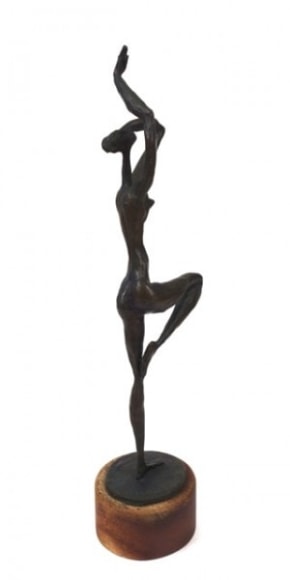Doris Caesar

Dancer, circa 1950's
Doris Caesar (1892 – 1971)
Doris Porter Caesar, a sculptor of bronze figures, was once described by John I. H. Gauer as “an expressionist in the northern tradition. She owes an obvious debt to Lehmbruch and Barlach, and like them traces her sculptural ancestry back to the romantic elongations of . . . north Gothic art”.
Porter was born in a fashionable neighborhood in Brooklyn. Her mother died when she was twelve, but she was very close to her successful and brilliant father, a lawyer with wide-ranging interests who took her with him on leisurely trips to Europe. He strongly supported her desire to be an artist, and by the age of sixteen she was already dividing her time between mornings at the proper Spence School for girls and afternoons in the bohemian atmosphere of the Art Students League. In the cafeteria of the League, she engaged in heated, “liberated” discussions of art and politics under the impetus of the Ash Can movement. In 1913, after four years of drawing (with George Bridgman) and painting, she married.
For twelve years, like so many women before and since, Doris Porter Caesars time was completely taken up by the care of her two sons and daughter, and the responsibilities of a well-to-do housewife. After 1925, she slowly began to reemerge as a sculptor. In the late twenties and early thirties, she worked very hard, struggling to find her own personal statement by doing many studies from the model. Her inspiring teacher at this time was Alexander Archipenko, the pioneering cubist who had recently arrived from Paris.
In 1927, Caesar cast her first bronze piece and carried it timidly to the Weyhe Gallery on Lexington Avenue in New York. E. Weyhe, a perceptive dealer who ran a combined bookstore-art gallery, was sensitive to the work of talented, but unknown artists. This visit proved to be the beginning of a long relationship, which resulted in a series of solo shows beginning in 1935.
Caesars development was very much affected by Weyhe, who was an enthusiast about German expressionist art. Caesar was greatly moved by the works of Wilhelm Barlach, Ernst Lehmbruck, and Kathe Kollwitz in his collection. From the start, she intuitively turned away from serene classical forms, such as those of Aristide Maillol, and distorted her figure pieces until they were extremely attenuatedalmost “stick-like.”
Starting in the forties, Caesar worked on sculpture groups like Mother and Child (1947) and Descent from the Cross (1950), using expressionist distortion and an emotional, loose style in which the unsmoothed thumb marks in the clay remain as a textural element in the finished bronzes. She often worked right through the night at her studio in the Sherwood Building in New York. Simultaneously, she was very active in artists organizations.
In the fifties, Caesar arrived at a fully developed personal style. She now restricted herself entirely to single, naked female figures in tense and tactile forms, elongated but smoother-surfaced, as in Torso (1953).
In the Litchfield, Connecticut studio to which she moved in 1957, she completed works of stripped-down, formal excitement and poignancy that culminated years of searching. Forty of her pieces were shown at the Whitney Museum in a four-person show entitled Four American Expressionists in 1959. Caesar died in Litchfield at the age of seventy-eight.
(Information for the biography above is based on writings from the book, “American Women Artists”, by Charlotte Streifer Rubinstein.)
Biography from the Archives of AskART
